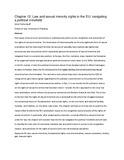| dc.contributor.author | Tryfonidou, Alina | |
| dc.date.accessioned | 2022-01-03T11:35:48Z | |
| dc.date.available | 2022-01-03T11:35:48Z | |
| dc.date.issued | 2020 | |
| dc.identifier.isbn | 9781788971270 | |
| dc.identifier.uri | http://hdl.handle.net/11728/12064 | |
| dc.description.abstract | Few issues incite as much controversy in contemporary politics as the recognition and protection of the rights of sexual minorities. The dominance of heterosexuality as the only legitimate form of sexual orientation and the silencing of all other discourses of sexuality have traditionally legitimised exclusionary laws and policies which completely ignored the existence of sexual minorities and relegated them to a second-rate position. In Europe, the first tentative steps towards the formation of an organised lesbian and gay liberation political movement were taken in the 1970s. Nonetheless, in the EU context, it took this political movement almost three decades before its efforts had begun to come to fruition, when the EU introduced its first legally binding instrument protecting sexual minorities from discrimination. This and other instruments have been interpreted by the CJEU in rulings which give mixed signals regarding the EU judiciary’s commitment to the protection of the rights of persons with non-heterosexual sexualities. In fact, it is not merely the EU judiciary’s stance on the rights of sexual minorities that has been mixed – overall, the EU’s approach to this issue has been ambivalent, which reflects the pressures exerted by the Member States in this field. This is due to the fact that the rights of sexual minorities are a contested terrain, where the struggles between the competing visions of ‘Europeanness’ and human rights, on the one hand, and national identity, morality and tradition, on the other, take place. This chapter will have as its main aim to examine the reasons that lie behind the EU’s ambivalent stance on the recognition and protection of the rights of sexual minorities. In particular, after analysing the protection currently offered to sexual minorities under EU law, the chapter will consider how the EU has navigated this political minefield and will seek to identify the main sites of interaction between law and politics when it comes to the recognition, respect and protection of the rights of persons with non-heterosexual sexualities. | en_UK |
| dc.language.iso | en_US | en_UK |
| dc.publisher | Edward Elgar Publishing | en_UK |
| dc.rights | Copyright © Edward Elgar Publishing 2016 | en_UK |
| dc.rights.uri | http://creativecommons.org/licenses/by-nc-nd/4.0/ | en_UK |
| dc.source.uri | https://www.elgaronline.com/view/edcoll/9781788971270/9781788971270.00021.xml | en_UK |
| dc.subject | Research Subject Categories::LAW/JURISPRUDENCE | en_UK |
| dc.subject | EU Legal framework | en_UK |
| dc.subject | Law and sexual minority rights | en_UK |
| dc.subject | fundamental rights | en_UK |
| dc.subject | non-discrimination | en_UK |
| dc.subject | sexual orientation | en_UK |
| dc.subject | lesbian | en_UK |
| dc.subject | gay | en_UK |
| dc.subject | bisexual rights | en_UK |
| dc.title | Law and sexual minority rights in the EU: navigating a political minefield | en_UK |
| dc.title.alternative | In book: Research Handbooks in Law and Politics. Edited by Paul James Cardwell and Marie-Pierre Granger | en_UK |
| dc.type | Book chapter | en_UK |
| dc.doi | 10.4337/9781788971287.00021 | en_UK |


